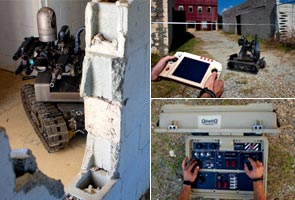- Home
- Others
- Others News
- War machines: Recruiting robots for combat
War machines: Recruiting robots for combat
By John Markoff, New York Times | Updated: 5 June 2012 02:22 IST

Click Here to Add Gadgets360 As A Trusted Source

Advertisement
War would be a lot safer, the Army says, if only more of it were fought by robots.
And while smart machines are already very much a part of modern warfare, the Army and its contractors are eager to add more. New robots -- none of them particularly human-looking -- are being designed to handle a broader range of tasks, from picking off snipers to serving as indefatigable night sentries.
In a mock city here used by Army Rangers for urban combat training, a 15-inch robot with a video camera scuttles around a bomb factory on a spying mission. Overhead an almost silent drone aircraft with a four-foot wingspan transmits images of the buildings below. Onto the scene rolls a sinister-looking vehicle on tank treads, about the size of a riding lawn mower, equipped with a machine gun and a grenade launcher.
Three backpack-clad technicians, standing out of the line of fire, operate the three robots with wireless video-game-style controllers. One swivels the video camera on the armed robot until it spots a sniper on a rooftop. The machine gun pirouettes, points and fires in two rapid bursts. Had the bullets been real, the target would have been destroyed.
The machines, viewed at a "Robotics Rodeo" last month at the Army's training school here, not only protect soldiers, but also are never distracted, using an unblinking digital eye, or "persistent stare," that automatically detects even the smallest motion. Nor do they ever panic under fire.
"One of the great arguments for armed robots is they can fire second," said Joseph W. Dyer, a former vice admiral and the chief operating officer of iRobot, which makes robots that clear explosives as well as the Roomba robot vacuum cleaner. When a robot looks around a battlefield, he said, the remote technician who is seeing through its eyes can take time to assess a scene without firing in haste at an innocent person.
Yet the idea that robots on wheels or legs, with sensors and guns, might someday replace or supplement human soldiers is still a source of extreme controversy. Because robots can stage attacks with little immediate risk to the people who operate them, opponents say that robot warriors lower the barriers to warfare, potentially making nations more trigger-happy and leading to a new technological arms race.
"Wars will be started very easily and with minimal costs" as automation increases, predicted Wendell Wallach, a scholar at the Yale Interdisciplinary Center for Bioethics and chairman of its technology and ethics study group.
Civilians will be at greater risk, people in Mr. Wallach's camp argue, because of the challenges in distinguishing between fighters and innocent bystanders. That job is maddeningly difficult for human beings on the ground. It only becomes more difficult when a device is remotely operated.
This problem has already arisen with Predator aircraft, which find their targets with the aid of soldiers on the ground but are operated from the United States. Because civilians in Iraq and Afghanistan have died as a result of collateral damage or mistaken identities, Predators have generated international opposition and prompted accusations of war crimes.
But robot combatants are supported by a range of military strategists, officers and weapons designers -- and even some human rights advocates.
"A lot of people fear artificial intelligence," said John Arquilla, executive director of the Information Operations Center at the Naval Postgraduate School. "I will stand my artificial intelligence against your human any day of the week and tell you that my A.I. will pay more attention to the rules of engagement and create fewer ethical lapses than a human force."
Dr. Arquilla argues that weapons systems controlled by software will not act out of anger and malice and, in certain cases, can already make better decisions on the battlefield than humans.
His faith in machines is already being tested.
"Some of us think that the right organizational structure for the future is one that skillfully blends humans and intelligent machines," Dr. Arquilla said. "We think that that's the key to the mastery of 21st-century military affairs."
Automation has proved vital in the wars America is fighting. In the air in Iraq and Afghanistan, unmanned aircraft with names like Predator, Reaper, Raven and Global Hawk have kept countless soldiers from flying sorties. Moreover, the military now routinely uses more than 6,000 tele-operated robots to search vehicles at checkpoints as well as to disarm one of the enemies' most effective weapons: the I.E.D., or improvised explosive device.
Yet the shift to automated warfare may offer only a fleeting strategic advantage to the United States. Fifty-six nations are now developing robotic weapons, said Ron Arkin, a Georgia Institute of Technology roboticist and a government-financed researcher who has argued that it is possible to design "ethical" robots that conform to the laws of war and the military rules of escalation.
But the ethical issues are far from simple. Last month in Germany, an international group including artificial intelligence researchers, arms control specialists, human rights advocates and government officials called for agreements to limit the development and use of tele-operated and autonomous weapons.
The group, known as the International Committee for Robot Arms Control, said warfare was accelerated by automated systems, undermining the capacity of human beings to make responsible decisions. For example, a gun that was designed to function without humans could shoot an attacker more quickly and without a soldier's consideration of subtle factors on the battlefield.
"The short-term benefits being derived from roboticizing aspects of warfare are likely to be far outweighed by the long-term consequences," said Mr. Wallach, the Yale scholar, suggesting that wars would occur more readily and that a technological arms race would develop.
As the debate continues, so do the Army's automation efforts. In 2001 Congress gave the Pentagon the goal of making one-third of the ground combat vehicles remotely operated by 2015. That seems unlikely, but there have been significant steps in that direction.
For example, a wagonlike Lockheed Martin device that can carry more than 1,000 pounds of gear and automatically follow a platoon at up to 17 miles per hour is scheduled to be tested in Afghanistan early next year.
For rougher terrain away from roads, engineers at Boston Dynamics are designing a walking robot to carry gear. Scheduled to be completed in 2012, it will carry 400 pounds as far as 20 miles, automatically following a soldier.
The four-legged modules have an extraordinary sense of balance, can climb steep grades and even move on icy surfaces. The robot's "head" has an array of sensors that give it the odd appearance of a cross between a bug and a dog. Indeed, an earlier experimental version of the robot was known as Big Dog.
This month the Army and the Australian military held a contest for teams designing mobile micro-robots -- some no larger than model cars -- that, operating in swarms, can map a potentially hostile area, accurately detecting a variety of threats.
Separately, a computer scientist at the Naval Postgraduate School has proposed that the Defense Advanced Research Projects Agency finance a robotic submarine system that would intelligently control teams of dolphins to detect underwater mines and protect ships in harbors.
"If we run into a conflict with Iran, the likelihood of them trying to do something in the Strait of Hormuz is quite high," said Raymond Buettner, deputy director of the Information Operations Center at the Naval Postgraduate School. "One land mine blowing up one ship and choking the world's oil supply pays for the entire Navy marine mammal program and its robotics program for a long time."
Such programs represent a resurgence in the development of autonomous systems in the wake of costly failures and the cancellation of the Army's most ambitious such program in 2009. That program was once estimated to cost more than $300 billion and expected to provide the Army with an array of manned and unmanned vehicles linked by a futuristic information network.
Now, the shift toward developing smaller, lighter and less expensive systems is unmistakable. Supporters say it is a consequence of the effort to cause fewer civilian casualties. The Predator aircraft, for example, is being equipped with smaller, lighter weapons than the traditional 100-pound Hellfire missile, with a smaller killing radius.
At the same time, military technologists assert that tele-operated, semi-autonomous and autonomous robots are the best way to protect the lives of American troops.
Army Special Forces units have bought six lawn-mower-size robots -- the type showcased in the Robotics Rodeo -- for classified missions, and the National Guard has asked for dozens more to serve as sentries on bases in Iraq and Afghanistan. These units are known as the Modular Advanced Armed Robotic System, or Maars, and they are made by a company called QinetiQ North America.
The Maars robots first attracted the military's interest as a defensive system during an Army Ranger exercise here in 2008. Used as a nighttime sentry against infiltrators equipped with thermal imaging vision systems, the battery-powered Maars unit remained invisible -- it did not have the heat signature of a human being -- and could "shoot" intruders with a laser tag gun without being detected itself, said Bob Quinn, a vice president at QinetiQ.
Maars is the descendant of an earlier experimental system built by QinetiQ. Three armed prototypes were sent to Iraq and created a brief controversy after they pointed a weapon inappropriately because of a software bug.
However, QinetiQ executives said the real shortcoming of the system was that it was rejected by Army legal officers because it did not follow military rules of engagement -- for example, using voice warnings and then tear gas before firing guns. As a consequence, Maars has been equipped with a loudspeaker as well as a launcher so it can issue warnings and fire tear gas grenades before firing its machine gun.
Remotely controlled systems like the Predator aircraft and Maars move a step closer to concerns about the automation of warfare. What happens, ask skeptics, when humans are taken out of decision making on firing weapons? Despite the insistence of military officers that a human's finger will always remain on the trigger, the speed of combat is quickly becoming too fast for human decision makers.
"If the decisions are being made by a human being who has eyes on the target, whether he is sitting in a tank or miles away, the main safeguard is still there," said Tom Malinowski, Washington director for Human Rights Watch, which tracks war crimes. "What happens when you automate the decision? Proponents are saying that their systems are win-win, but that doesn't reassure me."
And while smart machines are already very much a part of modern warfare, the Army and its contractors are eager to add more. New robots -- none of them particularly human-looking -- are being designed to handle a broader range of tasks, from picking off snipers to serving as indefatigable night sentries.
In a mock city here used by Army Rangers for urban combat training, a 15-inch robot with a video camera scuttles around a bomb factory on a spying mission. Overhead an almost silent drone aircraft with a four-foot wingspan transmits images of the buildings below. Onto the scene rolls a sinister-looking vehicle on tank treads, about the size of a riding lawn mower, equipped with a machine gun and a grenade launcher.
Three backpack-clad technicians, standing out of the line of fire, operate the three robots with wireless video-game-style controllers. One swivels the video camera on the armed robot until it spots a sniper on a rooftop. The machine gun pirouettes, points and fires in two rapid bursts. Had the bullets been real, the target would have been destroyed.
The machines, viewed at a "Robotics Rodeo" last month at the Army's training school here, not only protect soldiers, but also are never distracted, using an unblinking digital eye, or "persistent stare," that automatically detects even the smallest motion. Nor do they ever panic under fire.
"One of the great arguments for armed robots is they can fire second," said Joseph W. Dyer, a former vice admiral and the chief operating officer of iRobot, which makes robots that clear explosives as well as the Roomba robot vacuum cleaner. When a robot looks around a battlefield, he said, the remote technician who is seeing through its eyes can take time to assess a scene without firing in haste at an innocent person.
Yet the idea that robots on wheels or legs, with sensors and guns, might someday replace or supplement human soldiers is still a source of extreme controversy. Because robots can stage attacks with little immediate risk to the people who operate them, opponents say that robot warriors lower the barriers to warfare, potentially making nations more trigger-happy and leading to a new technological arms race.
"Wars will be started very easily and with minimal costs" as automation increases, predicted Wendell Wallach, a scholar at the Yale Interdisciplinary Center for Bioethics and chairman of its technology and ethics study group.
Civilians will be at greater risk, people in Mr. Wallach's camp argue, because of the challenges in distinguishing between fighters and innocent bystanders. That job is maddeningly difficult for human beings on the ground. It only becomes more difficult when a device is remotely operated.
This problem has already arisen with Predator aircraft, which find their targets with the aid of soldiers on the ground but are operated from the United States. Because civilians in Iraq and Afghanistan have died as a result of collateral damage or mistaken identities, Predators have generated international opposition and prompted accusations of war crimes.
But robot combatants are supported by a range of military strategists, officers and weapons designers -- and even some human rights advocates.
"A lot of people fear artificial intelligence," said John Arquilla, executive director of the Information Operations Center at the Naval Postgraduate School. "I will stand my artificial intelligence against your human any day of the week and tell you that my A.I. will pay more attention to the rules of engagement and create fewer ethical lapses than a human force."
Dr. Arquilla argues that weapons systems controlled by software will not act out of anger and malice and, in certain cases, can already make better decisions on the battlefield than humans.
His faith in machines is already being tested.
"Some of us think that the right organizational structure for the future is one that skillfully blends humans and intelligent machines," Dr. Arquilla said. "We think that that's the key to the mastery of 21st-century military affairs."
Automation has proved vital in the wars America is fighting. In the air in Iraq and Afghanistan, unmanned aircraft with names like Predator, Reaper, Raven and Global Hawk have kept countless soldiers from flying sorties. Moreover, the military now routinely uses more than 6,000 tele-operated robots to search vehicles at checkpoints as well as to disarm one of the enemies' most effective weapons: the I.E.D., or improvised explosive device.
Yet the shift to automated warfare may offer only a fleeting strategic advantage to the United States. Fifty-six nations are now developing robotic weapons, said Ron Arkin, a Georgia Institute of Technology roboticist and a government-financed researcher who has argued that it is possible to design "ethical" robots that conform to the laws of war and the military rules of escalation.
But the ethical issues are far from simple. Last month in Germany, an international group including artificial intelligence researchers, arms control specialists, human rights advocates and government officials called for agreements to limit the development and use of tele-operated and autonomous weapons.
The group, known as the International Committee for Robot Arms Control, said warfare was accelerated by automated systems, undermining the capacity of human beings to make responsible decisions. For example, a gun that was designed to function without humans could shoot an attacker more quickly and without a soldier's consideration of subtle factors on the battlefield.
"The short-term benefits being derived from roboticizing aspects of warfare are likely to be far outweighed by the long-term consequences," said Mr. Wallach, the Yale scholar, suggesting that wars would occur more readily and that a technological arms race would develop.
As the debate continues, so do the Army's automation efforts. In 2001 Congress gave the Pentagon the goal of making one-third of the ground combat vehicles remotely operated by 2015. That seems unlikely, but there have been significant steps in that direction.
For example, a wagonlike Lockheed Martin device that can carry more than 1,000 pounds of gear and automatically follow a platoon at up to 17 miles per hour is scheduled to be tested in Afghanistan early next year.
For rougher terrain away from roads, engineers at Boston Dynamics are designing a walking robot to carry gear. Scheduled to be completed in 2012, it will carry 400 pounds as far as 20 miles, automatically following a soldier.
The four-legged modules have an extraordinary sense of balance, can climb steep grades and even move on icy surfaces. The robot's "head" has an array of sensors that give it the odd appearance of a cross between a bug and a dog. Indeed, an earlier experimental version of the robot was known as Big Dog.
This month the Army and the Australian military held a contest for teams designing mobile micro-robots -- some no larger than model cars -- that, operating in swarms, can map a potentially hostile area, accurately detecting a variety of threats.
Separately, a computer scientist at the Naval Postgraduate School has proposed that the Defense Advanced Research Projects Agency finance a robotic submarine system that would intelligently control teams of dolphins to detect underwater mines and protect ships in harbors.
"If we run into a conflict with Iran, the likelihood of them trying to do something in the Strait of Hormuz is quite high," said Raymond Buettner, deputy director of the Information Operations Center at the Naval Postgraduate School. "One land mine blowing up one ship and choking the world's oil supply pays for the entire Navy marine mammal program and its robotics program for a long time."
Such programs represent a resurgence in the development of autonomous systems in the wake of costly failures and the cancellation of the Army's most ambitious such program in 2009. That program was once estimated to cost more than $300 billion and expected to provide the Army with an array of manned and unmanned vehicles linked by a futuristic information network.
Now, the shift toward developing smaller, lighter and less expensive systems is unmistakable. Supporters say it is a consequence of the effort to cause fewer civilian casualties. The Predator aircraft, for example, is being equipped with smaller, lighter weapons than the traditional 100-pound Hellfire missile, with a smaller killing radius.
At the same time, military technologists assert that tele-operated, semi-autonomous and autonomous robots are the best way to protect the lives of American troops.
Army Special Forces units have bought six lawn-mower-size robots -- the type showcased in the Robotics Rodeo -- for classified missions, and the National Guard has asked for dozens more to serve as sentries on bases in Iraq and Afghanistan. These units are known as the Modular Advanced Armed Robotic System, or Maars, and they are made by a company called QinetiQ North America.
The Maars robots first attracted the military's interest as a defensive system during an Army Ranger exercise here in 2008. Used as a nighttime sentry against infiltrators equipped with thermal imaging vision systems, the battery-powered Maars unit remained invisible -- it did not have the heat signature of a human being -- and could "shoot" intruders with a laser tag gun without being detected itself, said Bob Quinn, a vice president at QinetiQ.
Maars is the descendant of an earlier experimental system built by QinetiQ. Three armed prototypes were sent to Iraq and created a brief controversy after they pointed a weapon inappropriately because of a software bug.
However, QinetiQ executives said the real shortcoming of the system was that it was rejected by Army legal officers because it did not follow military rules of engagement -- for example, using voice warnings and then tear gas before firing guns. As a consequence, Maars has been equipped with a loudspeaker as well as a launcher so it can issue warnings and fire tear gas grenades before firing its machine gun.
Remotely controlled systems like the Predator aircraft and Maars move a step closer to concerns about the automation of warfare. What happens, ask skeptics, when humans are taken out of decision making on firing weapons? Despite the insistence of military officers that a human's finger will always remain on the trigger, the speed of combat is quickly becoming too fast for human decision makers.
"If the decisions are being made by a human being who has eyes on the target, whether he is sitting in a tank or miles away, the main safeguard is still there," said Tom Malinowski, Washington director for Human Rights Watch, which tracks war crimes. "What happens when you automate the decision? Proponents are saying that their systems are win-win, but that doesn't reassure me."
Comments
Get your daily dose of tech news, reviews, and insights, in under 80 characters on Gadgets 360 Turbo. Connect with fellow tech lovers on our Forum. Follow us on X, Facebook, WhatsApp, Threads and Google News for instant updates. Catch all the action on our YouTube channel.
Related Stories
Popular on Gadgets
- Samsung Galaxy Unpacked 2025
- ChatGPT
- Redmi Note 14 Pro+
- iPhone 16
- Apple Vision Pro
- Oneplus 12
- OnePlus Nord CE 3 Lite 5G
- iPhone 13
- Xiaomi 14 Pro
- Oppo Find N3
- Tecno Spark Go (2023)
- Realme V30
- Best Phones Under 25000
- Samsung Galaxy S24 Series
- Cryptocurrency
- iQoo 12
- Samsung Galaxy S24 Ultra
- Giottus
- Samsung Galaxy Z Flip 5
- Apple 'Scary Fast'
- Housefull 5
- GoPro Hero 12 Black Review
- Invincible Season 2
- JioGlass
- HD Ready TV
- Laptop Under 50000
- Smartwatch Under 10000
- Latest Mobile Phones
- Compare Phones
Latest Gadgets
- Huawei Nova 15
- Huawei Nova 15 Pro
- Huawei Nova 15 Ultra
- OnePlus 15R
- Realme Narzo 90x 5G
- Realme Narzo 90 5G
- Vivo S50 Pro Mini
- Vivo S50
- Asus ProArt P16
- MacBook Pro 14-inch (M5, 2025)
- Huawei MatePad 11.5 (2026)
- OnePlus Pad Go 2 (5G)
- Huawei Watch 10th Anniversary Edition
- OnePlus Watch Lite
- Acerpure Nitro Z Series 100-inch QLED TV
- Samsung 43 Inch LED Ultra HD (4K) Smart TV (UA43UE81AFULXL)
- Asus ROG Ally
- Nintendo Switch Lite
- Haier 1.6 Ton 5 Star Inverter Split AC (HSU19G-MZAID5BN-INV)
- Haier 1.6 Ton 5 Star Inverter Split AC (HSU19G-MZAIM5BN-INV)
© Copyright Red Pixels Ventures Limited 2025. All rights reserved.
















